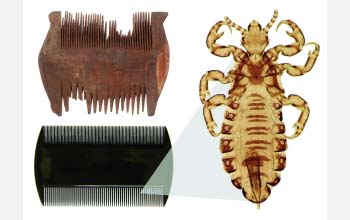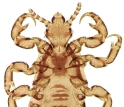News Release 04-139
Head Lice Study Supports Direct Contact Between Modern and Archaic Humans

Battling an ancient enemy. The picture shows a 6th century wooden nit comb from the Egyptian cit ...
October 4, 2004
This material is available primarily for archival purposes. Telephone numbers or other contact information may be out of date; please see current contact information at media contacts.
Arlington, Va.— New research showing that lice evolve with the people they infest demonstrates that a now-extinct species of human, Homo erectus, came into direct contact with modern humans, Homo sapiens. That contact happened as recently as 25,000 years ago.
Evidence of contact between the two species of humans is surprising, scientists say, because researchers long had thought that Homo erectus became extinct hundreds of thousands of years ago.
The study's findings appear in the Oct. 5 online issue of the Public Library of Science journal, PloS, Biology.
People today have two distinct types of head lice: one that evolved on Homo erectus, and one that evolved on Homo sapiens. The only way that could have happened, say scientists, is by direct contact between the two species.
"It's amazing to know that we had physical contact with another species of human," said David Reed, curator of mammals at University of Florida's (UF) Florida Museum of Natural History and the lead scientist on the study. "We touched them, and that's pretty dramatic to think about. We either battled with them, or lived with them or perhaps even mated with them," he said.
Scientists already believed that early ancestors of our species diverged from other archaic humans about 1.2 million years ago. Reed's study shows that two nearly identical but genetically different strains of head lice diverged at about the same time. Each of the two kinds of head lice infested a different species of early human as the human species diverged, Reed and colleagues propose.
"This research pioneers the use of parasites to tell us about the natural history of humans and other animals," said Carter Kimsey, program director in the National Science Foundation (NSF)'s division of biological infrastructure, which co-funded the research with NSF’s division of environmental biology. It gives biologists and anthropologists a new tool, said Kimsey.
"We've discovered the ‘smoking louse’ that reveals direct contact between two early species of humans, probably in Asia about 25,000 to 30,000 years ago," said co-author Dale Clayton of the University of Utah. Other authors of the paper include Alan Rogers of the University of Utah, Vincent Smith of the University of Glasgow in Scotland and Shaless Hammon of the University of Utah.
"The record of our past is written in our parasites," said Rogers.
Lice require direct physical contact between hosts for transmission. They also form new species each time the host, in this case humans, does, Reed said, making them excellent markers for tracing human evolutionary history.
After infesting Homo erectus for a million years, one type of louse jumped from that soon-to-be-extinct species onto Homo sapiens.
The research confirms the "out-of-Africa" theory that the population of Homo sapiens rapidly expanded after a small group of our early ancestors left Africa between 150,000 and 50,000 years ago. Other recent studies had suggested that Homo sapiens indeed may have had contact with Homo erectus not in Africa, but in Asia, 50,000 years ago.
-NSF-
-
An enlarged image of a human head louse.
Credit and Larger Version
Media Contacts
Cheryl Dybas, NSF, (703) 292-7734, email: cdybas@nsf.gov
Program Contacts
Carter Kimsey, NSF, (703) 292-8400, email: ckimsey@nsf.gov
The U.S. National Science Foundation propels the nation forward by advancing fundamental research in all fields of science and engineering. NSF supports research and people by providing facilities, instruments and funding to support their ingenuity and sustain the U.S. as a global leader in research and innovation. With a fiscal year 2023 budget of $9.5 billion, NSF funds reach all 50 states through grants to nearly 2,000 colleges, universities and institutions. Each year, NSF receives more than 40,000 competitive proposals and makes about 11,000 new awards. Those awards include support for cooperative research with industry, Arctic and Antarctic research and operations, and U.S. participation in international scientific efforts.
Connect with us online
NSF website: nsf.gov
NSF News: nsf.gov/news
For News Media: nsf.gov/news/newsroom
Statistics: nsf.gov/statistics/
Awards database: nsf.gov/awardsearch/
Follow us on social
Twitter: twitter.com/NSF
Facebook: facebook.com/US.NSF
Instagram: instagram.com/nsfgov



